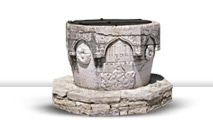
- Sečovlje Salt Pans - Dragonja River Valley
- Sv. Peter - Nova vas - Padna
- Pomjan - Nature Park: Karst Edge - Socerb
- Črni Kal - Osp - Kubed
- Momjan - Grožnjan - Pietrapelosa - Mirna
- Baštija - Kostanjica - Parenzana
- Oprtalj - Završje - Livade - Zrenj
- Istarske toplice - Motovun Forest - Višnjan
- Cave Mramornica - Feštini Kingdom - Cave Baredine
- Lim Bay - Kloštar - Kontija - Dvigrad
- Kanfanar - Bale - Palud - Vodnjan -Islands Brijuni - Fažana
- Svetvinčenat - Tinjan - Pićan - Gračišće
- Belaj - Šumber - Kožljak - Paz
- Čepićko Field - Kršan - Boljun Castle - Lupoglav
- Plomin - Kvarner Gulf - Brseč
- Nature park Učka - Mošćenice
Momjan - Grožnjan - Pietrapelosa - Mirna
Mirna
This décor in the scenery gives the Istrian landscape certain tranquility, hiding the secret of the role and power it had in the past. Mirna is the longest Istrian river (32 kilometers); its source is in the area of Buzet, in the Kotli Valley. Traveling towards the sea it passes the Buzet and Motovun Valleys, under the bridge Ponte Porton until its mouth, near Antenal. Its entire course is enriched with tributaries on both sides. The first mention of the river is tied to the nice legend about the Argonauts, Greek seamen who in 1200 BC captured the Golden Fleece on the shores of the Black Sea in Asia Minor, and traveled along rivers and underground waters to the Mirna River and settled on the slopes. This is, however, only one of the legends that brought Istria a patina of unreality.
The present day mouth of the Mirna River was navigable in Antiquity. This was done by barge that connected the Novigrad area with these parts. Namely, at the very mouth of the river is Antenal, in Roman times a port, with sea and land routes leading across it. Even the largest ships could land there. It was a port until the Middle Ages, one of the largest quays in the Northern Adriatic where as many as 50 boats of different flags were moored.
In navigable times, upstream towards Ponte Porton, in the vicinity of the fortification St. George was a small quay whose stone blocks for tying ships exist even nowadays. This was probably the site of a toll house for river navigation, as well as small ports Pešina and Nengon near Nova Vas, that served the inhabitants of Brtonigla and Krasica for transport of wine, olive oil, grain, fruit and wood downstream towards the sea and further to Trieste and Venice. They completely disappeared during the 19th c. and today are covered with silt and soil deposits.
Print page Send to a friend
















